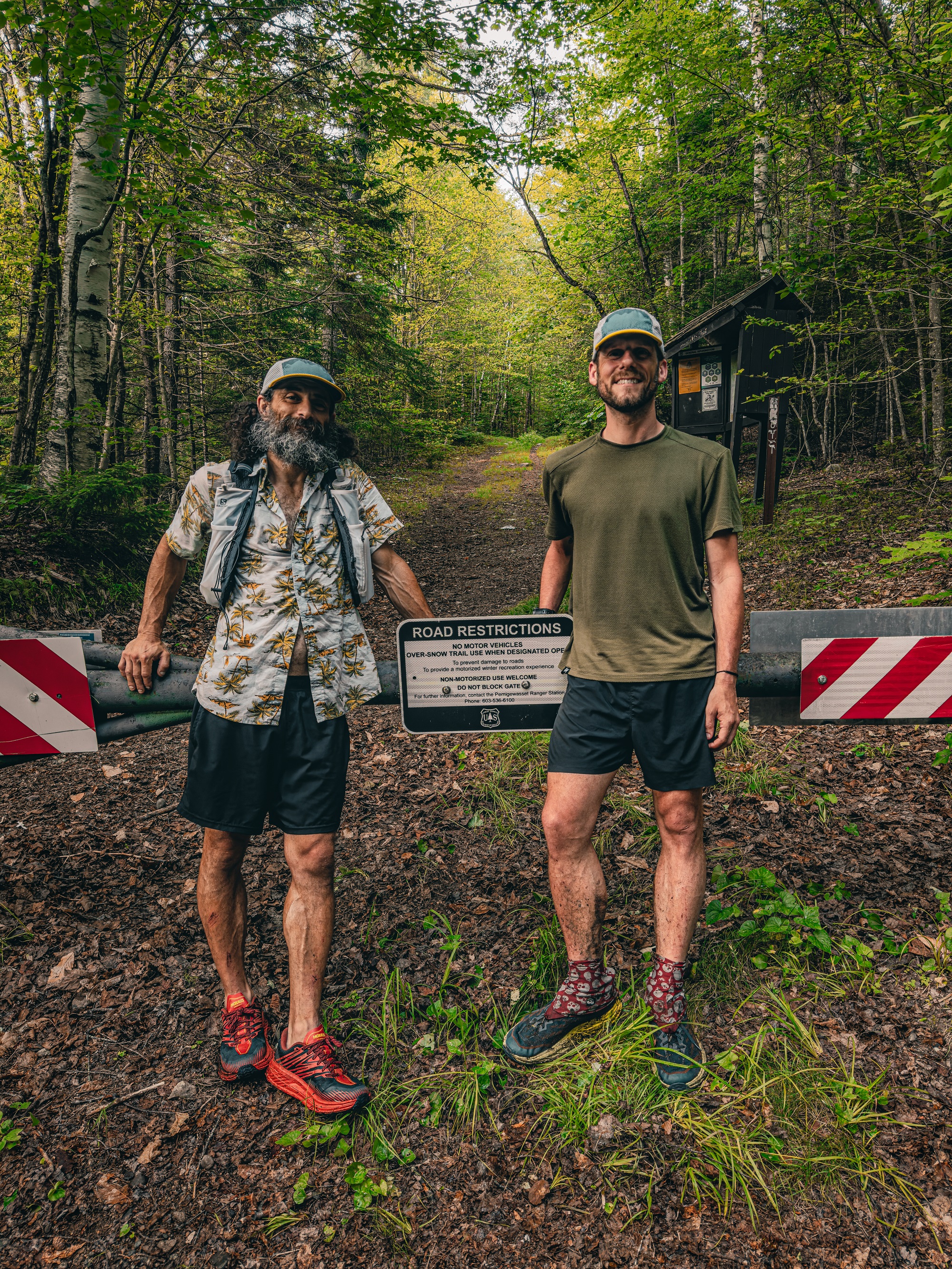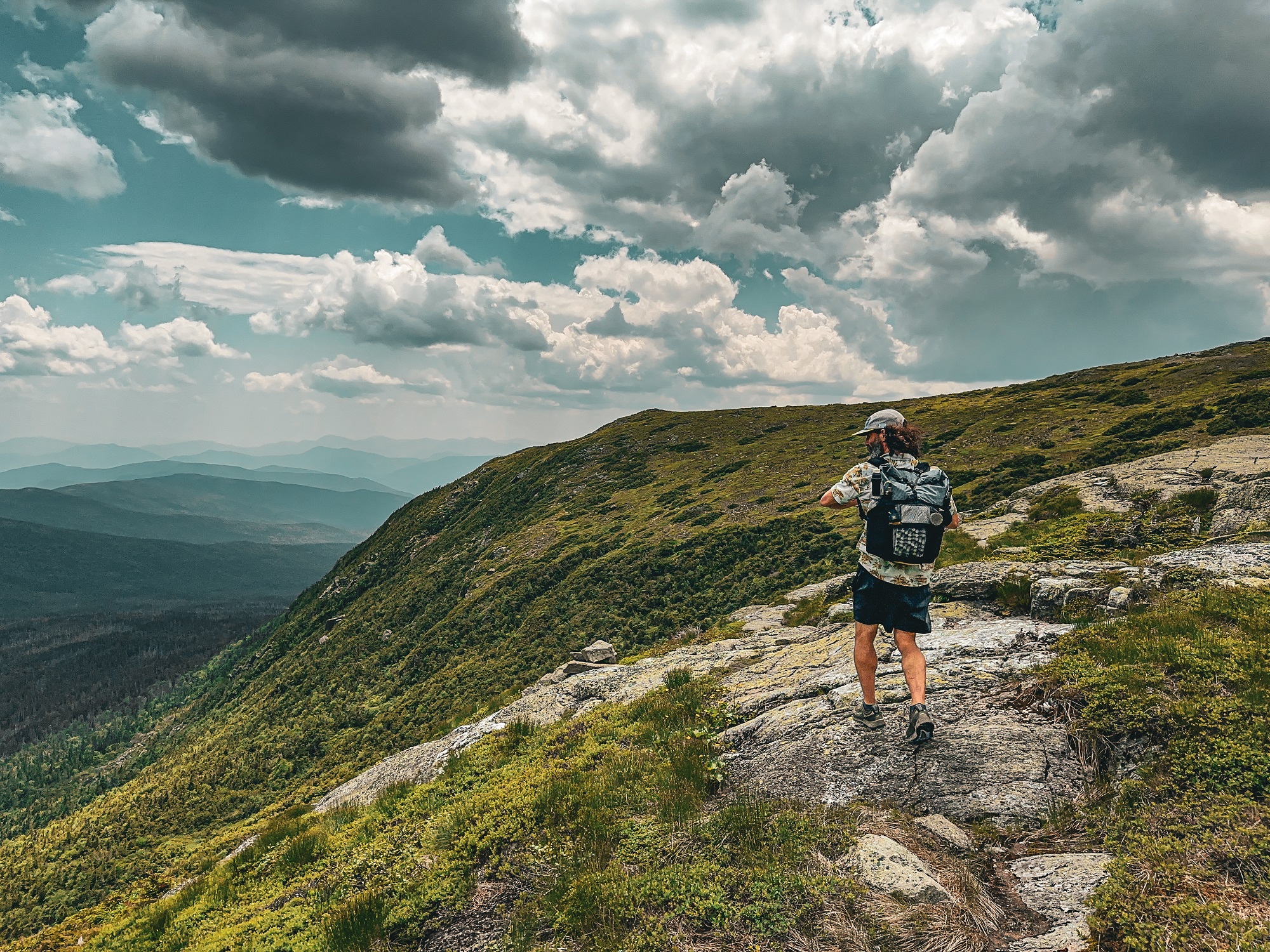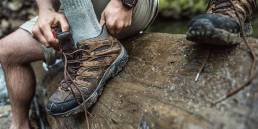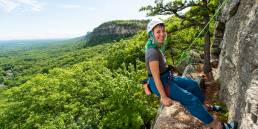If you think you know the White Mountains because you’ve notched the 48 4,000-footers, think again. Philip Carcia, a 39-year-old career hiker we met in a February profile, is always thinking of new ways to approach the mountains, both physically and as a visual artist.
About Philip Carcia
Carcia averages 2,500-2,800 miles on foot each year and has done both a single-year grid (all of the 48 4,000-footers in each month of the year) as well as a single-season White Mountains Guidebook challenge (hiking all of the approximately 1,400 miles of trails in the mountain guidebook in 90 days). He has also tackled other interesting, cutting-edge endurance projects in the White Mountain National Forest and New England, such as an out-and-back crossing of the Kancamagus Highway on foot and summiting Mount Wachusett a staggering 35 times in a calendar day.
While his output is hard to match, his imagination is as well. His latest challenge, the White Mountains Wilderness Route (WMWR), links the six wilderness areas in the White Mountains—the Caribou-Speckled Wilderness, Wild River Wilderness, Great Gulf Wilderness, Presidential Range-Dry River Wilderness, Pemigewasset Wilderness, and Sandwich Range Wilderness—via many lesser-traveled routes. He and a couple of friends, Andrew Soares and Declan Kiley, set out to complete the 115-mile route in three days this summer. Things didn’t go exactly as planned.

Q: It sounds like the challenge of linking the wilderness areas was tougher than you thought it would be, perhaps humbling?
A: I think I underestimated it slightly because I have hiked all of these trails individually at a minimum of three times. I thought about days out there [doing the White Mountains Guide] and how different it was, then approached the trails in this context. I have tended to think “I’ve seen the worst of it, it won’t be more exhausting than it was in the context of trying to finish the White Mountains Guide in a single summer.” But let me tell you, these trails are wilderness with a capital “W.”
This challenge is comprised of what I consider to be some of the least-traveled trails in the White Mountains. They are certainly unkept, vacant of people for the most part, and they truly highlight the aesthetic of these places. With that aesthetic or personality comes a lot of friction, a lot of problems to kind of fix on the fly, and a lot of things that make this something different than a more traditional thru-hike. It humbled me every day.
Many of the notable but seldom visited trails and places include:
- Speckled Mountain
- Basin Brook Reservoir
- Mount Meader
- Eagle Crag
- Perkins Notch
- Spaulding Lake
- Great Gulf Headwall
- Oakes Gulf Headwall
- Mount Davis
- Stairs Mountain
- Nancy Cascade
- Nancy Pond
- Still Water Junction
- Hancock Notch
- Black Mountain Pond
- Guinea Pond
Q: Mosquitos were a significant obstacle. That doesn’t sound so awful, but …?
A: I was excited to show these guys (Andrew and Declan) places they wouldn’t normally see in the White Mountains National Forest under normal conditions. But we didn’t encounter normal conditions. The heat index was around 90 degrees the entire time, and we’d had the wettest couple of weeks on record. We were soaked in the first 10 minutes and realized it was going to be very hot, very wet, and 115 miles of mosquitos and black flies. These things would affect our forward momentum and lead to Declan quitting the trail early [due to slower-than-anticipated progress and his work obligations]. It was a super difficult trip for me; these things made it hard to keep my head in the game.
Still, I always love getting out to these areas, I always love doing things in the White Mountains that others haven’t done before. I always love diving into the creative and trying to figure out different avenues to document and share the projects afterward.
[Editor’s note: after completing the route, Carcia and his companions learned that another hiker, Kae Pat, was working on their own version of a Wilderness Route linking all of the six distinct wilderness areas.]
Q: And this is your idea of an easy summer?
A: Yes. This year, I’ve taken a little time to process and chill out physically and mentally. This summer has unfolded in the way I hoped it would. I’ve taken a 6-7 month period and checked off all of the little bucket list projects, single and multi-day projects in the White Mountains and the Northeast that I haven’t been able to tend to for the last three, four, or five years because I’ve been married to the grid, married to the single-season White Mountain Guidebook. So now I feel like I have freedom and just the output to start swinging on a lot of these smaller, fun projects, and in the process, take on something like the Wilderness Route, which I have waited patiently the last three years to take on and introduce to the community.
Between June and October, I will likely take on 4-6 single and multi-day projects. It feels different in terms of my approach because it’s not a massive single-year project, but I think these routes and challenges will definitely find their place in the annals of endurance in the White Mountains National Forest.
Q: What’s your plan for your next massive project?
A: I’d like to combine two massive projects—the single-year grid and the single-season White Mountains Guide, which is all 48, 4,000-foot mountains in every month and all 650 trails of the White Mountains Guide simultaneously. It will take a lot of support to be ready to put a start date on the calendar, to make the commitment to that project. I’ll need [sponsors] to live and get calories, to drive, to fix my car.
Q: In your Instagram Live session [@FindingPhilip], you said you’re a performance artist. Is it because you’re sick of people trying to categorize and label what you do?
A: I’ve learned in five years in the endurance community we love our titles and our labels. “Are you a hiker, are you a runner, are you a peak bagger, are you a mountain climber, are you an FKTer, are you the fastest, have you gone the furthest, are you traveling supported, unsupported, self-supported?”
These nuances are important in the culture, and I respect that, but titles have become pretty irrelevant to me. In fact, if I were to give myself any title right now, it would be “performance artist.” When I was 13 years old, I was given a camera and I’ve been shooting photos and videos for most of my adult life. Filmmaker, photographer, and artist were the first titles I ever cared about having and the first real genuine passions I ever had. I’ve always wanted to stay connected with that artist’s energy. In the outdoor space, I think we take that for granted.
But that’s what this is. The hiking thing, getting up on these mountains in the morning, showing them in the different seasons, and bringing them to people who would never have the opportunity to see this stuff in real life—it’s performance art. With as real and open and honest and genuine and non-performative as we’re trying to make the experience, we go into it knowing that a large number of people, what I would refer to as our audience, are going to see what we did out there.
Understand the impact you’re having on your community, how important the creative component is to your hiking, your running, your project work, and embrace it. Share the journey as openly and honestly and as vulnerably as you can, because that is the one thing in my eyes that kind of shifts the focus away from this being a selfish practice and allows it to affect and impact and inspire other people.
Once you acknowledge that, understand it, and lean into it, things start to get very, very, very interesting.

What Finding Philip Hopes Hikers Will Discover
According to Carcia, the intention for the WMWR is not to lead a hiker across iconic 4,000-footers or easy-to-identify landmarks. Rather, the goals are to connect all six federally designated wilderness areas in the White Mountain National Forest, while balancing both practicality and aesthetic. It aims to avoid well-traveled trails commonly used to access New Hampshire’s 4,000-footers and give the accomplished athlete in the White Mountains an opportunity to explore and test themselves in the most remote corners of the National Forest.
Carcia hopes other people will test themselves on the route. Trail maps and route descriptions are available on his website.
Alison O'Leary
Alison O’Leary is an avid cross country skier, author, and public speaker. See alisonoleary.com.
Related Posts
April 24, 2024
What to Bring When Road Tripping with Your Dog
Prepare for the ultimate road trip with…




